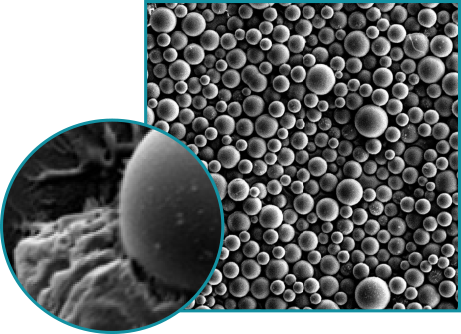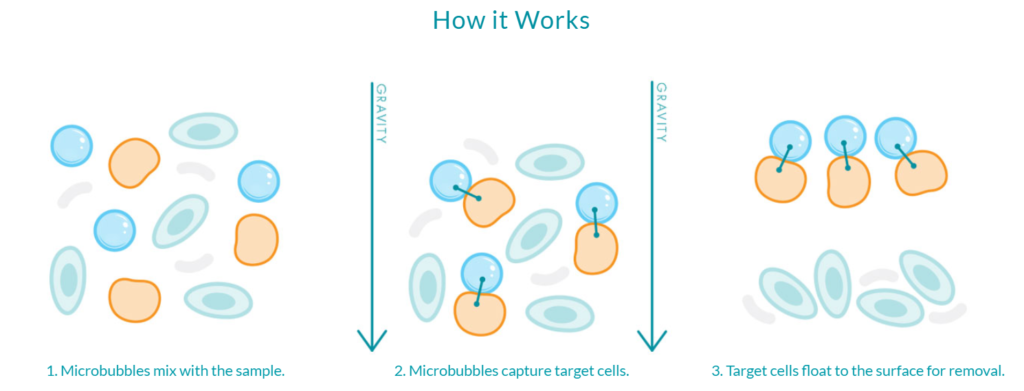Microbubbles: A New Way to Separate Cells
Microbubbles are miniature, gas-filled bubbles that offer a simple solution to a nearly infinite range of applications. While they have been used for a variety of different things, Akadeum Life Sciences have found a way to harness their natural properties for cell separation technology.
Microbubble-based cell sorting allows smaller laboratories to scale up their diagnostic capabilities and isolate rare, fragile cells. These applications would not be possible if not for the size and structure of microbubbles.
What are Microbubbles Made Of?
In general, microbubbles can be made of a variety of materials. There is typically a gas center surrounded by a shell constructed of polymers, lipids, or proteins.
Akadeum’s microbubbles are a polydisperse mixture of thin glass microspheres with a gaseous core. We use glass-shelled microbubbles for two main reasons:
- The specific density of our microbubbles allows them to lift several cells to the top of a heterogenous mixture.
- The glass shell provides a stable structure that prevents the microbubbles from popping.
These glass microbubbles are then coated with antibodies or streptavidin to target cells.
How Big are Microbubbles?
Microbubbles can range in size from micrometers (μm), which are one millionth of a meter, to nanometers (nm), which are one billionth of a meter. The size has everything to do with the application. When it comes to cell separation the microbubbles must be in something of a Goldilocks Zone, a perfect medium where 
At Akadeum, our polydisperse microbubbles are just thick enough to withstand the movement without bursting. Their size provides them enough buoyant force to float cells to the top of a fluid sample.
Why are Microbubbles Important?
Microbubbles allow for the gentle transportation of extremely small cells or particles. They rely on the rules of physics and nothing else to get the job done, read more on the physics of microbubble sorting. Other methods can alter or damage cells, skewing the results of downstream applications or practices. Microbubbles are small, simple, and efficient, saving the user time and money whenever applicable.
How Do Microbubbles Work? What is BACS Cell Separation?
Microbubbles rely on the physical properties of buoyancy to carry out their function. Buoyancy is the force that allows less dense molecules to float in liquid. If the buoyant force of microbubbles is enough to overcome the force of gravity acting on the target cells, the bubbles can float upwards.

Akadeum has harnessed these tendencies to develop an innovative microbubble cell separation technique called buoyancy activated cell sorting (BACS). BACS begins by mixing the microbubbles into the cell sample, which overcomes their natural buoyancy. This allows the bubbles to bind with as many target cells as possible throughout the mixture.
After capturing target cells, microbubbles will lift them to the top of the sample, leaving behind unwanted cells. Microbubbles and the cells attached to them are then removed through a process called aspiration.

Cell Aspiration as a Cell Recovery Protocol
Akadeum recommends using vacuum aspiration to remove the microbubbles and supernatant following enrichment. This process only tampers with the cells at the top of the solution, leaving the enriched sample untouched at the bottom of the container.
Other Cell Isolation Methods
Other methods used for cell sorting include the following:
- Fluorescence activated cell sorting (FACS) – This method uses a flow cytometer to sort cell populations by their physical characteristics. By running the cells one-by-one through a laser the machine can decide where they need to be sorted.
- Magnetic bead-based cell sorting – This method uses antibody-coated microbeads to bind with target cells, then activates a magnetic field to suspend target cells in the sample. Once all the other cells have been removed, the field is turned off.
- Centrifugation – This method uses a device called a centrifuge to spin cell samples. Depending on their density, certain particles will move to the outside and others will group towards the center.
While all of these cell separation strategies have specific use cases, they all also have disadvantages associated with them.
Why Use Microbubble Technology?
BACS is fast, gentle, and relatively inexpensive in comparison to the other separation methods. While other methods require complex, costly machinery, BACS can be done with nothing but the separation kit. The microbubbles can be mixed directly into the sample container.
If your laboratory is trying to perform cell isolation with the intention of using those cells for downstream research or application, using BACS is one way to ensure that your cells will be viable after the process is complete.
Are Microbubbles a Good Fit for My Project?
Microbubbles and BACS can be used to sort high volume samples or isolate rare cell populations with high viability. , Akadeum offers cell separation kits for the following cell types:
- Human T Cell Isolation Kit – Removes unwanted cells from peripheral blood samples with up to 95% purity.
- Human CD4+ T Cell Isolation Kit – Negatively selects CD4+T helper cells from peripheral blood with up to 95% purity.
- Mouse T Cell Isolation Kit – Enriches T cells from mouse splenocytes with a high yield and up to 96% purity.
- Mouse CD4+ T Cell Isolation Kit – Offers high yield, easy to use CD4+ helper T cell isolation from mouse splenocytes with up to 96% purity.
- Mouse Naïve T Cell Isolation Kit – Negatively selects naïve T cells, which require a gentle method, from the spleen of a mouse with 96% purity.
- Mouse Naïve CD4+ T Cell Isolation Kit – Negatively selects naïve CD4+ T cells from mouse splenocytes with 96% purity for accurate downstream applications.
- Mouse B Cell Isolation Kit – Easy to use kit that filters unwanted cells from murine B cells, allowing a high yield and 95% purity.
Akadeum also offers a Human Red Blood Cell Depletion Kit that can be used to help purify sorted samples. This can work in conjunction with other cell separation methods to decontaminate an isolated sample for downstream applications.
There is also a Streptavidin Microbubbles Kit which scientists can customize with their own biotinylated antibodies. This allows for a much wider range of cell populations to be targeted as long as the lab has access to the necessary biomolecules.
Akadeum’s Microbubble Technology
Microbubbles optimize the cell separation process for time, ease, and overall cost. Using an efficient method that requires no additional steps or equipment can help to reduce the headache while still delivering accurate results. This simplicity makes it easy for labs and manufacturers to begin integrating microbubble cell separation into workflows with minimal disruption.
For more information on microbubble technology and how they’re used for BACS, download the Ultimate Guide to Microbubble Technology on our resources page. This guide provides in-depth information on the processes and principles followed when performing cell separation with microbubbles.


